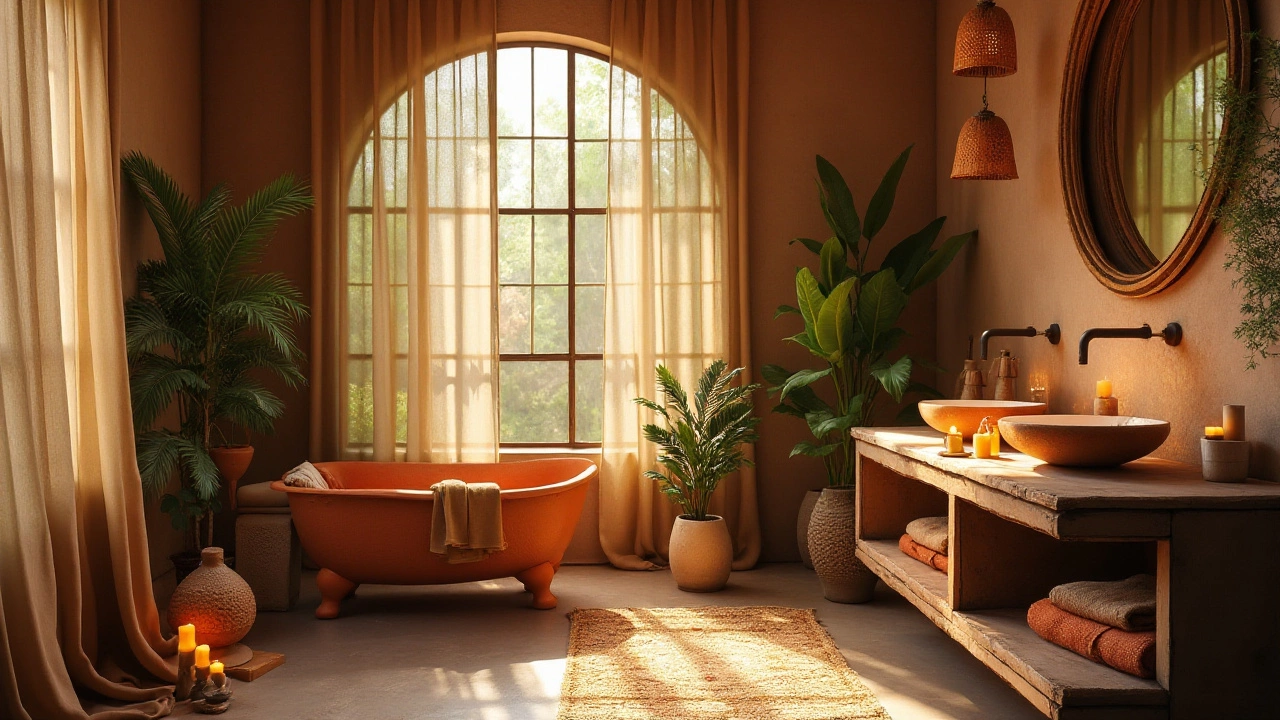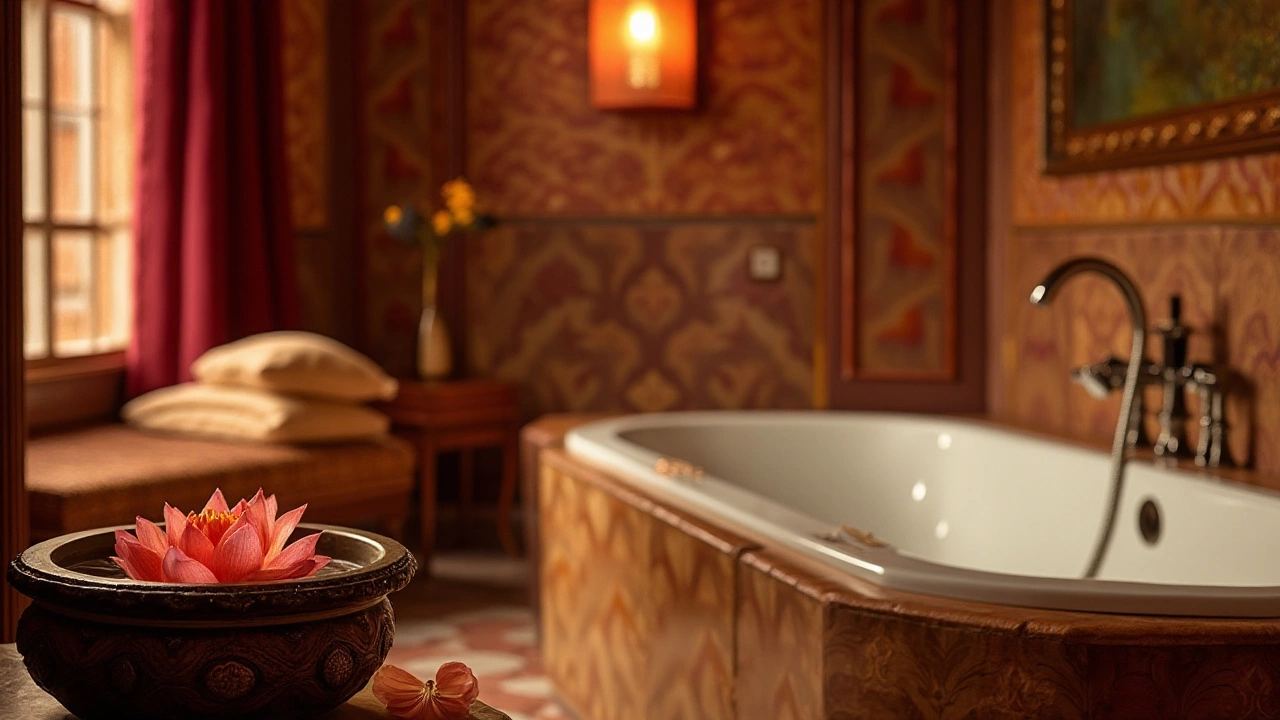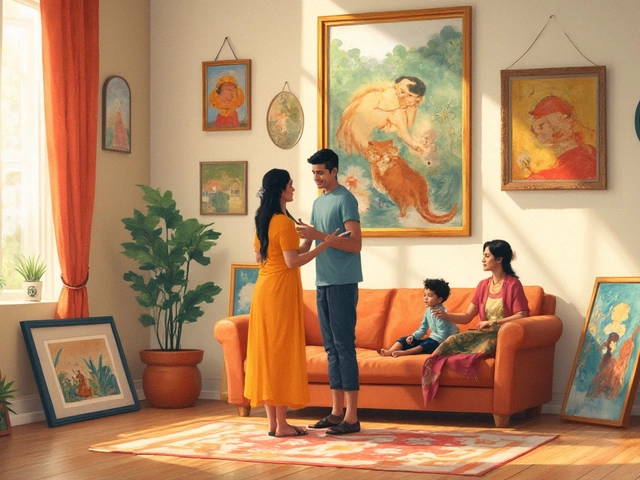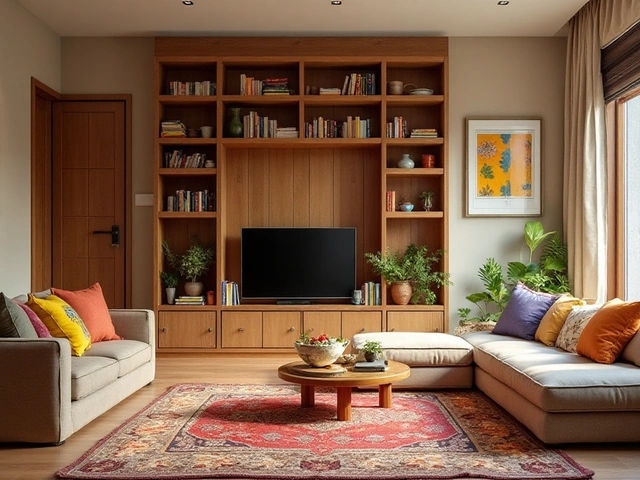Ever thought about the power of color when it comes to designing an elegant bathroom? It turns out, the shades you choose can speak volumes about sophistication and style. Step into the realm of luxurious bathrooms where the right palette transforms even the humblest of spaces into something truly special.
Dive into an exploration of colors that don't just add visual appeal; they redefine the concept of a tranquil retreat. From classic neutrals to the shine of metallics, the right color can make all the difference. Whether you prefer the soothing serenity of muted tones or the daring splash of an accent wall, discover how to create a bathroom that exudes class and comfort.
- Understanding Luxury in Color
- Timeless, Rich Neutrals
- Vibrant Accent Colors
- The Magic of Metallics
- Texture and Color Coordination
Understanding Luxury in Color
When it comes to creating a luxury bathroom, color is more than just a visual feature; it is a language that speaks to the senses, inviting relaxation and opulence. Color in this context has the power to turn an ordinary washroom into an extraordinary retreat. The selection of the right hues can influence moods, change perception of space, and enhance the natural light present. The psychological impact of color is a fascinating one; studies show that humans respond emotionally to different hues, and this can be strategically used to craft a sanctuary within the walls of your home.
Neutral colors such as taupe, gray, and off-white are often the backbone of luxury bathroom decor. These shades exude sophistication, offering a backdrop that feels timeless yet contemporary. Scientists and interior designers alike agree that such shades have a calming effect, reducing stress and promoting a sense of well-being. On a subtle note, the neutrality allows for a play of textures and accessories, creating depth while maintaining elegance. The neutrality of these colors makes them highly versatile, effortlessly combining with other hues to form harmonious designs.
Imagine stepping into a bathroom detailed with rich marbles accented by soft gold fixtures. The magic here lies within the careful curation of color interaction—a concept many luxury spaces employ expertly. According to interior designer Kelly Wearstler, "Color, once combined with texture and form, has the potential to elevate any mundane element into something breathtaking." It's through successful color orchestration that a sense of balance between elegance and warmth is achieved, offering a tranquil escape from daily life.
The strategic use of vibrant colors can also enhance a bathroom's expensive look. Deep blues, lush greens, and royal purples can add a dramatic flair, especially when paired with the sleek sheen of polished chrome or aged brass fittings. There's an art to introducing bold colors without overwhelming the senses. Spreading these vibrant tones through accessories, artwork, or feature walls can inject personality without detracting from the serene atmosphere essential for an indulgent bathing space.
The use of color does not stop with paint. Tiles, fixtures, and textiles offer platforms to infuse these luxurious tones more subtly. Consider the opulence of a luxuriously soft teal bath towel against a creamy white vanity or the understated elegance of a charcoal shower curtain against a backdrop of light stone tiles. This seamless mix of colors and materials defines a space that not only looks expensive but feels like an oasis of comfort and style. Understanding these concepts is crucial for crafting a bathroom that universally impresses while offering personal sanctuary.
Timeless, Rich Neutrals
When it comes to creating a bathroom that whispers elegance and refinement, few choices are as astute as rich neutrals. These colors are the quiet heroes of interior design, offering a plush canvas that complements any decorative style. Think of shades like taupe, beige, charcoal, and soft grays—they may not be the loudest in the crayon box, but they are undoubtedly the classiest. This palette allows the other elements in the bathroom—the slick faucet, the artisanal tiles, or even the vintage mirror—to shine. Neutrals provide that understated touch, giving a modern, sleek feel while keeping a warm invitation. One reason why they’re beloved is their adaptability. These hues can slide effortlessly between contemporary and classic, aligning with any design statement.
These shades also foster tranquility and relaxation, which is precisely what you need in a sanctuary space like the bathroom. Bathroom colors set the tone; imagine stepping into a space painted in calming clay or mushroom gray. The entire room seems to exhale, creating an air of zen that’s hard to achieve with brighter palettes. It’s no wonder designers frequently reach for these hues. In the words of renowned designer Nathan Turner, "Neutrals possess a beauty that's inviting without overshadowing. They guide you easily through decades yet never go out of style."
Incorporating textures alongside neutral colors is another way to amplify their appeal. A combination of glossy and matte surfaces can create depth, drawing attention to subtly overlooked details. You may consider elements like a marble countertop or a smooth polished wood cabinet—each piece adding its layer to the minimalist crux. The effect is a bathroom that looks decidedly upscale without the need for elaborate embellishments. Luxury bathroom aesthetics often depend on these nuances that play on light and shadow.
The beauty of rich neutrals lies in their simplicity. They don’t need to scream for attention; they’re naturally captivating and always in vogue. By choosing such a palette, you allow flexibility in updating details, like adding or swapping accessories, while maintaining a cohesive design. Never underestimate the power of these subtle stars; as they consistently stand the test of time, your bathroom remains an icon of sophisticated taste.

Vibrant Accent Colors
When dreaming of a bathroom that feels high-end and inviting, one should not shy away from incorporating vibrant accent colors. These hues can turn what might have been a plain, functional space into a showstopper. Imagine a touch of teal or a splash of coral against a backdrop of muted tones—such combinations not only draw the eye but also inspire a sense of joyful luxury. The secret lies in balance: vibrant colors must be used tastefully to harmonize with the rest of the decor. It's essential to choose shades that enhance, rather than overpower, the existing palette. Jewel tones like emerald and sapphire offer a sophisticated allure that can make your bathroom feel rich and inviting.
Accent colors can be introduced in several ways. For example, through feature walls, decorative tiles, and accessories like towels or artwork. A bold mustard or a vibrant red framed in a mosaic tile design can stand as a centerpiece of creativity. Using accent colors in patterned rugs or shower curtains can add depth and intrigue without committing to a permanent change. However, these colors need to be chosen thoughtfully to avoid creating a dissonant effect. Textured elements, combined with strong contrasting hues, can set the stage for a warm yet elegant ambiance. Luxury bathroom aesthetics thrive on such strategic use of accent colors.
"Color is a power which directly influences the soul," said the maestro of colors, Wassily Kandinsky. This quote encapsulates the transformational power of vibrant colors in a space intended for relaxation and rejuvenation.
Striking a balance between luxury and playfulness can also be achieved with a well-planned color scheme. Contrasting vibrant colors with calming neutrals can make a statement while maintaining a serene atmosphere. Consider the impact of a bright orange or a confident turquoise juxtaposed against a classic white. It's a dynamic combination that instantly elevates the environment to one of chic elegance. These combinations not only speak to modern sensibilities but also provide endless opportunities for personalization. The interplay of bold colors with more subdued tones creates an environment that feels simultaneously trendy and timeless. Also, don't underestimate the power of artwork or a colored bathroom vanity, which can be a focal point and introduce an unexpected pop of color.
What's truly exciting about employing vibrant accent colors is the flexibility they afford in evolving your style over time. With a few swipes of a brush or new accessories, the mood of the space can shift dramatically. Design lovers enjoy the chance to refresh the palette according to season or trend without having to start from scratch. This adaptability makes vibrant colors an excellent choice for those who appreciate the luxury of ever-evolving aesthetics. Remember, when these bold hues are chosen with care and paired skillfully, they have the power to imbue even the simplest bathroom with an aura of expense and refinement.
The Magic of Metallics
Something captivating happens when shiny metallics enter the stage of interior design, especially in the domain of the bathroom. It’s not just about their distinctive sheen but the elegance and touch of luxury they bring to any space. Metallics, such as gold, silver, or the more contemporary favorite, rose gold, have the power to elevate a bathroom instantly. When used thoughtfully, these tones can catch the light in the most charming way, casting a gentle glow that enhances the ambiance without overwhelming. The play of light on metallic surfaces creates an ever-changing canvas of reflections, an effect that's both mesmerizing and soothing.
Imagine walking into a bathroom where metallics serve more than a decorative purpose. They bring a sense of depth and sophistication that few other finishes can achieve. Whether it's through brushed nickel fixtures or gleaming brass details, the impact is undeniable and compelling. According to interior designer Nate Berkus, "If you’re going to invest in a bathroom, invest in the faucets or the hardware first; those pieces act as jewelry for the room."
He emphasizes that the right metallic accent can anchor the room’s aesthetic, making other design elements stand confidently.When you start seeing metal as a texture beyond just color, the design possibilities expand.
The charm of metallics lies not only in their shimmer but in their versatility. They fit seamlessly within various styles, from the ultra-modern to the classically ornate. You might find an elegantly curved chrome tap alongside a vintage vanity or a matte black metal frame artfully juxtaposed against white marble. This adaptability is particularly important as it demonstrates the ability of metallics to bridge gaps between different design choices. An understated metallic grill can add character to minimalist settings, while an ornate gold mirror frame can transform a traditional setup into something palatial.
Let’s not forget about the multiple ways in which metallics can be incorporated. Fixtures are an obvious choice, but don’t neglect the less obvious paths. How about a tin-paneled ceiling for an unexpected, vintage flair, or copper piping that brings an industrial touch? For those on a budget, even small additions, like chrome light switch covers or brass towel bars, can lend a luxurious feel without a hefty investment. Even when minimal, metallics can catch the eye, make you linger, and instill an appreciation for those thoughtful details that define a space’s personality.
Statistics have shown that homes featuring well-executed metallic accents often see an increase in perceived property value. According to a Kitchen & Bath Design report, about 40% of prospective home-buyers were more likely to favor properties with modernized, metallic-accentuated bathrooms. Imagine the result: by choosing the right fixtures and accessories, you’re not only cultivating a beautifully luxurious space but also making a savvy financial decision. Such is the double-edged advantage of using metallics.

Texture and Color Coordination
When striving to make a bathroom look expensive, one cannot overlook the seamless marriage between color and texture. This duo plays a critical role in crafting a cohesive and inviting space. Textures breathe life into colors, offering depth and character that plain, flat surfaces just can't rival. For instance, imagine a combination of soft matte walls with sleek, glossy tiles — the visual contrast can be incredibly striking. Plush towels in rich, inviting colors enhance not only the visual appeal but also the tactile experience, adding an element of warmth and luxury.
There’s a charming complexity when coordinating bathroom colors with different textures. It's like orchestrating a visual symphony where each piece meshes harmoniously. Consider pairing a pale beige stone tile with polished bronze fixtures. The raw, earthy component of the stone juxtaposed against the gleaming metal creates a dynamic interaction that is both elegant and grounded. A subtle variation like a warm-toned wood vanity can bridge the connection between the two, unifying the room's elements distinctly.
Creating a Visual Balance
Achieving a sense of visual balance requires a discerning eye for color coordination. It’s all about weaving various textures together without creating chaos. One effective technique is using a neutral bathroom color as a backdrop and playing with textures in complementary shades. For example, go for a charcoal gray wall and accent it with a plush, cream-colored rug or a tufted ottoman. Such pairings invite a luxurious feel while maintaining sophistication.According to renowned interior designer, Nate Berkus, "Whether it's tile, wallpaper, or paint, the texture can be as important as color in a room. The texture gives depth, so the room feels vibrant and not flat."
"Texture dictates the level of glamour and echo throughout the space, bringing a tangible quality to any chosen hue."
An engaging trick to consider is mixing natural and artificial elements. For instance, juxtaposing marble with polished chrome or soft leather can ignite a sumptuous experience. The sheen and reflection off polished surfaces welcome light play, which is critical in making compact bathrooms feel larger and more inviting. Texture affects how color is perceived, allowing some hues to appear more intense or muted depending on the surface's quality.
Strategic Use of Patterns
Patterns in the bathroom can add a touch of exclusivity and make the overall design feel bespoke. Introducing a patterned tile in a luxury bathroom doesn't only elevate color schemes; it provides a tactile sensation that enlivens the space. Opt for geometric patterns or classic herringbone in a monotone scheme for a timeless look. A wall clad in mosaic tiles of subtly different shades can be the pièce de résistance of the bathroom, acting as a focal point. These intricate designs naturally command attention and signify high design standards.Harmony between texture and color can be further augmented by personalization. It's vital to align these elements with one's personality and lifestyle. Patina finishes, for example, are ideal for those who appreciate a vintage feel, offering an aged, tactile charm that evokes stories of time gone by. On the other hand, someone seeking a modern aesthetic might lean toward smooth, high-gloss textures paired with bold accent colors. Such a texture-color strategy ensures that the bathroom evolves into an extension of one's taste while remaining a sanctuary of elegance.





